Are you interested in measuring how fast your road bike can go? Most avid cyclists agree that a good average speed to aim for is 20mph.
Of course, this isn’t necessarily achievable on every ride and depends heavily on the terrain – hills and wind resistance can slow riders down considerably.
If you’re curious about your own personal speed and want to find out the hard numbers, we recommend using a smartwatch with GPS or cyclocomputer — both record distance over time and other data, telling you exactly how fast you’ve been riding.
Knowing your speed is essential, but what’s the ideal average pace depending on your experience? We’ve gathered information from riders at all levels and have a comprehensive guide to show you the way.
What’s The Average Road Bike Speed?
The average road bike speed varies widely depending on the terrain, type of road, weather conditions and your level of fitness. Uphill climbs will naturally be slower than flat roads, for instance.
There is no one-size-fits-all answer to this question as each rider’s speed will vary greatly. That said, the average speed for road bike riders on flat terrain is around 17-22 mph or 28-35 km/h.
Experienced cyclists can reach higher speeds, but beginners and leisurely riders may go slower than that. That’s because your legs and lungs gets stronger as you ride.
In general, riding in a group will make it easier to maintain high speeds as it allows you to draft off of others and can provide motivation. So, if you’re looking to hit higher speeds, riding with a group is often the best way to go.
Ultimately, however, it’s up to each individual rider to determine their own speed.
What’s The Average Bike Speed for Beginners?
If you’re new to cycling, you may be wondering what the average speed is for beginner cyclists. The truth is, it’s hard to give a firm answer; everyone responds differently to fitness training and has different abilities.
Generally speaking though, the average road bike speed for beginners tends to be on the slower side. This is because it takes time to build up the physical strength and endurance to increase your speed when biking.
Also worth noting is that beginner women cyclists may go slightly faster than men and may be able to ride longer, as they often have lighter frames and more flexibility in their bodies.
Generally speaking, if you’re just starting out on cycling, your average speed should range between 10-12 mph during your ride. This means that you should be able to cover a distance of 2-3 km in less than twenty minutes.
After six months or so of dedicated practice, you can expect to see an improvement in your performance and abilities; at this point in time, most cyclists enjoy an average speed range of 15-16 mph or 24-25 km/h.
It is important to note that everybody is different when it comes to cycling skills; however the average bike speed for beginners can provide useful guidance for someone just getting started with their cycling journey.
Factors Impacting Average Bike Speed
There are many things that impact cycling speed, too many to cover in full detail in any single article. However, these factors fall into larger categories that allow us to organize and make sense of them. They are Physiological Factors, Psychological Factors, Environmental Factors, and Mechanical Factors.
1. Physiological Factors
Our bodies are the engines that make a bicycle move. Our conditioning plays an obvious role in how much speed we can generate while riding, and how well we sustain this speed.
But, it’s not only our fitness level that makes the difference. There are many elements, some completely beyond our control, that shape this statistic for us.
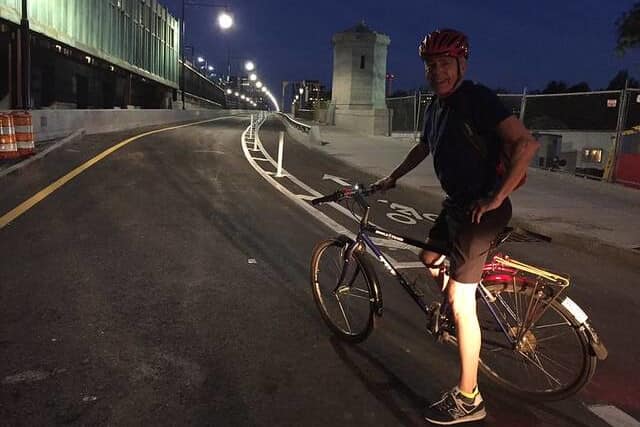
Age
As we grow older, our bodies decline in many measurable ways relevant to our cycling performance.
The ability to deliver oxygen to the muscles is reduced as the tissues of the heart harden the ventricles thicken, lessening the volume of blood flow. After 30, sarcopenia, the loss of muscle mass, begins to slowly eat away at our strength at a rate that can exceed 5% per decade.
Yet, the cyclist who keep up their training and riding beyond 30 can dramatically reduce these performance losses. Avid riders can expect to lose about a mile off of their average speed between the ages of 20 and 60, though that figure is about a half-mile higher for older male riders on long trips.
Gender
Speaking of the difference between male and female numbers, the rule of thumb is that men tend to have higher average speeds than women.
This has to do with physiological differences. Women have less hemoglobin, which is the protein that carries oxygen around in the blood. Women also generally have less blood than men. These things together mean that women have a lower cardiovascular performance ceiling than men.
Men also have the advantage of testosterone, which boosts performance even further. Women, on the other hand, have to contend with hormonal changes, particularly as they age and enter menopause. This impacts their ability to retain muscle mass, even if they are training hard.
Women tend to have average speeds 1-3 miles slower than men in their same age group, though the gap lessens with age.
Fitness
Your physical conditioning is the one physiological factor over which you have influence, and it has the largest impact on your average cycling speed.
To maximize speed, cyclists need to train their leg muscles for both power and speed. Pedaling in heavy gears is made easier by building new muscle and increasing overall strength. Fast-pedaling in high gears benefits from training fast-twitch muscle fibers and your nervous system response.
Weight is also important, and lean cyclists with minimal body fat have an advantage over their heavier competitors.
Fitness is what accounts for the average speed of a pro cyclist being roughly twice that of a beginner.
2. Psychological Factors
When it comes to the mind’s impact on performance, there are two main considerations: perception and skill.

Perception
The wrong perception can cause you to cut back on your effort before you have reached your peak. You can become demoralized from the very sight of a hill ahead, and slow down preemptively. Fixating on your aching muscles can enlarge the pain and discomfort in your mind.
This effect has been proven using an interesting method: music. A cyclist who ride while listening to fast paced music ride faster for longer. The music distracts them from the discomfort they would normally feel.
Likewise, focusing on energy output versus perceived effort has proven helpful to many. For instance, when riding up a hill, it is possible to maintain the same energy output as when riding on flat ground.
You will be going slower, but you won’t actually be working harder. Seeing your numbers on a tracker provides objectivity and the motivation to continue. The longer you ride at a steady pace, the greater your average speed.
Skill
Riding skillfully arises from learning all the little tricks that only experience can teach. What is the most comfortable position on your bike? How far forward should you lean?
Skillful riders automatically fall into the ideal position, elbows tucked in, body forward to reduce drag. They intuitively know how to switch their cadence to best match a situation and utilize the environment to their advantage.
3. Environmental Factors
Everything from the road you ride on to the air you ride through can add or subtract speed from your ride. More than that, the fundamental forces of the physical world are the ultimate arbiters of what helps and what does not.
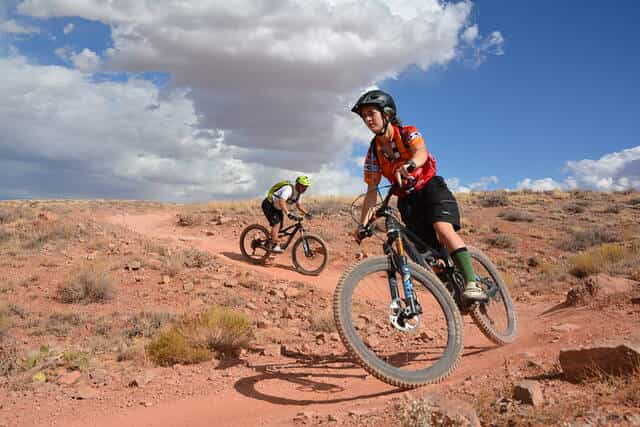
Terrain
The best speeds will be obtained on flat, even paths. As the way becomes more uneven, rocky, or sandy speed decreases. So you should always take sandy or dusty roads as your last option.
Likewise, riding uphill dramatically reduces your speed. An incline as little as 4% can result in a 75% reduction in speed, and it only gets worse the steeper it becomes.
Weather
If you’ve ever tried riding into a headwind, you understand that nature can impose a pretty brutal speed limit. The same is true for rain, snow, and ice. You’re going to ride slowly in such conditions, as it’s the only safe way to proceed.
The temperature matters, too. Cycling in the cold usually involves wearing bulkier clothing that will increase drag. Conversely, in hot weather, you can wear the most aerodynamic clothing. Additionally, hot air is less dense, so drag is reduced when it’s warmer.
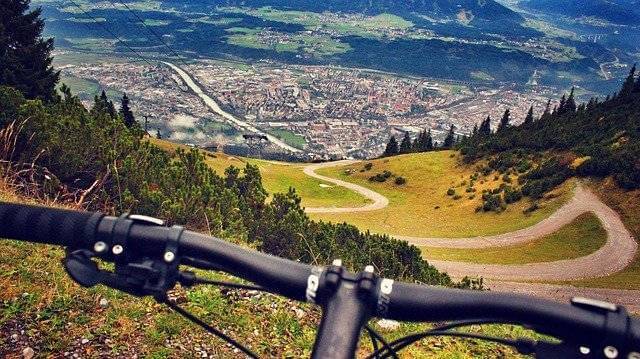
Physics
Ultimately, forces such as drag, momentum, and gravity are what really determine how all the other factors impact your motion.
Inclines and declines are a perfect example. Riding uphill is slower because it involves fighting against gravity in addition to battling wind resistance. Conversely, going downhill is such a breeze because you work with gravity.
Pumping the brakes drains off your kinetic energy and kills your momentum, slowing you down. While sometimes this is unavoidable, a cyclist who breaks less has higher, more consistent overall speeds. It pays to work with the forces of the universe.
4. Mechanical Factors
Finally, there is the role of the bike itself. Different types of bikes can attain different top speeds. Achieving that optimal performance requires that the bike be well maintained.
Bicycle Types
There are many types of bicycles, though the three most common are road bikes, mountain bikes, and hybrid bikes. As their names suggest, they are each made to meet particular demands, and their designs reflect this.
Road bikes are the lightest and fastest type of bike. They are often made of aluminum or carbon fiber to minimize frame weight, and feature drop bar style handlebars to allow the rider to change posture to suit the situation.
Road bikes are intended to be ridden on flat, uniform surfaces, the best terrain for achieving consistent speed. Cyclists on these bikes will have the highest average speeds.
Mountain and hybrid bikes are not exactly slow, and they certainly outpace road bikes in off-road conditions. However, they are made of heavier material to withstand the punishment of rough riding and have wider profiles making them subject to more drag.
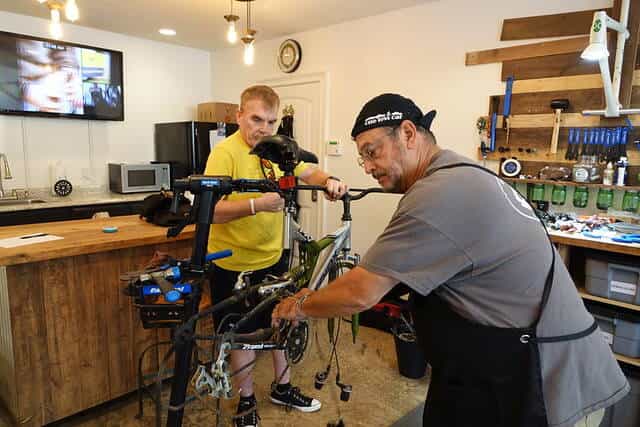
Maintenance
A bike that is cared for will outpace one that is neglected. Luckily, bikes are fairly simple to maintain. The two points of concern most relevant to speed are the tires and the chain.
Always keep your tires properly inflated. It’s worth it to check their pressure before each ride, in case there is a slow leak.
Under-inflated tires can reduce your average speed by .32 mph (.5 km/h), which is not a trivial amount, especially over long distances.
Tread loss is another thing to check for. Bald tires gain less traction, causing the tires to inefficiently translate your pedaling energy into forward motion. You should replace tires with worn treads immediately.
As for chains, you would surely notice if your chain is dragging due to bent links or rust, but it might surprise you to know that not all chain problems are visibly apparent.
The lubricant on your chain captures all sorts of grit and debris as you ride. That film of detritus creates extra friction in the drive train, sapping a tiny amount of your pedaling force.
However, visibly dirty chains, such as those crusted with mud from a rainy-day ride, can lose more than 5% of the energy you put in. It may not seem like much, but it will have a negative impact on your average bike speed.
Age | Speed MPH | Speed KM/H |
16 – 18 | 15 | 24 |
18 – 20 | 16.7 | 27 |
20 – 25 | 18.6 | 30 |
25 – 30 | 21.7 | 35 |
30 – 35 | 20.8 | 33.5 |
35 – 40 | 18.6 | 30 |
40 – 45 | 17.7 | 28 |
45 – 50 | 15 | 24.5 |
50 – 70 | 11.5 | 18 |
What’s The Average Cycling Speed By Age?
The average cycling speed by age can vary greatly depending on the individual’s physical condition, experience level, and the type of terrain they are riding on.
In general, younger cyclists tend to have higher average speeds than older cyclists due to their greater physical capabilities. However, this doesn’t mean that older cyclists should give up on cycling altogether.
With regular training and exercise, older cyclists can still achieve their target speeds.
In general, the average cycling speed for adults can range anywhere from 16.7 mph to 11.5 mph, depending on their age and other factors.
18-20 year olds tend to have the fastest average cycling speed, typically around 16.7 mph. For 20-25 year olds, their average speed is slightly higher at 18.6 mph.
This then peaks for 25-30 year olds with an average of 21.7 mph before decreasing slightly for 30-35 year olds at 20.8 mph. After this age, average cycling speed decreases steadily, with 35-40 year olds at 18.6 mph, 40-45 year olds 17.7 mph, 45-50 year olds at 15 mph and those 50+ averaging 11.5 mph.
Don’t be discouraged if someone of any age outrides you, for they may have been cycling since childhood. Each journey is unique and your own speed should not affect the joy it brings!
7 Easy Tips To Improve Average Bike Speed
For some, being a cyclist is all about speed. Be it they want to be the fastest cyclist around town, or they just like the feeling of the wind in their face.
Thankfully you do not always need to spend a lot of money on an upgrade or switch to a lighter frame design to go faster. At least for the methods I know about and used in past.
This is why we’re sharing with you the seven best tips to not only make your bicycle faster but ensure it remains a speed machine for years to come!
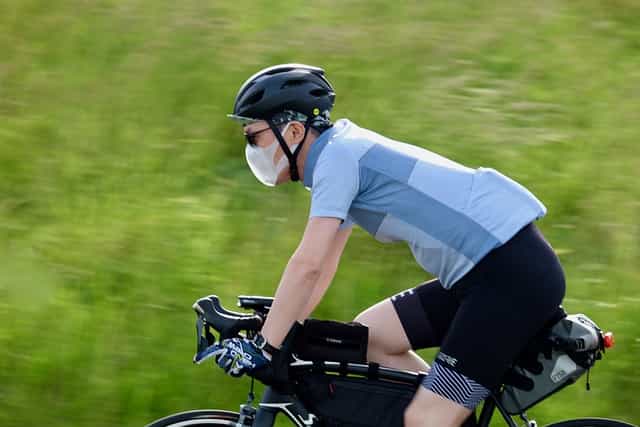
1. Reduce Wind Resistance
The biggest thing slowing you down is the wind resistance. The more upright your position is the more wind you need to face and thus slower you go for the same effort.
Luckily it’s easiest of all to fix, all you need to do is to bend forward and tuck your elbows in. You can maximize the effects by adjusting handlebar positions or using aerodynamic bike helmets like the ( Giro Vanquish MIPS Adult Aero Cycling Helmet ); Personally I do both.
Making the adjustment is quite simple, To adjust your handlebar remove the fork and take out a spacer before adding the stem back with the removed spacer now on top.
Read Also: Flat Bar vs Drop Bar For Commuting | Which One Better
I would suggest you switch to a drop bar when commuting for long-distance. The drop bars aerodynamic design helps lessen drag as your body catches less headwind.
This helps you go faster with a drop bar with the exact same effort. making it quite useful when climbing uphill on paved tracks. The ability to shift your weight forward gives additional leverage for efficient pedaling. Now you can pedal faster and with more power as you shift your weight forward.
2. Efficient Use of Conditions
You can go 15 % faster if you know how to best use the conditions. For example it will be wise to ride out in a tailwind that gives an extra boost to your speed.
When commuting to work its even better you ride out in a head wind and return in tailwind. In morning you are fresh and energetic and thus can put extra effort to maintain speed. But its the return when you need the wind boost as you being already exhausted.
If possible plan ahead for the wind condition and road types, as you will find it easier to ride on a smooth road than one with patchy uneven surface.
Then there is some basic common sense to take bike lanes and sidewalks to escape the busy city roads.

3. Pump Up Your Tires
For anyone with a bicycle, the most important adjustment they should make to improve the average bike speed is to monitor and adjust the tire pressure.
If you feel that your bike is running sluggish, check the tire pressure gauge before investing in new and expensive tires or taking it to the shop for repairs.
Tires with low pressure create more rolling resistance, which cuts back on speed.
Correctly inflated tires will rolls faster, invest in a air pump like Topeak Joe Blow Sport III High Pressure Floor Bike Pump ( Check price on Amazon ) to get the pressure you need.
Making sure your tire pressure is correct is the simplest step to ensuring your bike is fast. It’s also one of the easiest and cheapest, as all you really need is a pressure gauge and an air pump.
Some cyclists go the extra mile and adjust the pressure into both tires to give them that extra advantage and while this is certainly a tactic you can try, 100 to 120 psi should be good enough for most cyclists.
4. Do Work On Yourself
One of the basic ways to improve your average bike speed by doing work on yourself. This can be in the form of regular training biking, strength training, working your legs, and lifting weight at the gym.
Luckily you can do most of what’s needed with your own bike or at home. Pushing very big gears at slow speed is better than most squats and leg exercise taught elsewhere.
Only catch is you should do it in small sets and not more than 30 minutes in total, unless you want to break your knees. Find best gear which requires you to pedal slowly then slowly switch to faster gears.
Mix biking with your morning exercise and you get your strength training.
Cycling is known to strengthen your calves and help with fat loss. On the one hand, the fat loss makes your calves and legs leaner. Working your calves build muscles and help them grow bigger.
Lower weight helps you go faster while a more grown up calves muscles helps put more effort. So You rips the profit of both power and speed doing just one job.
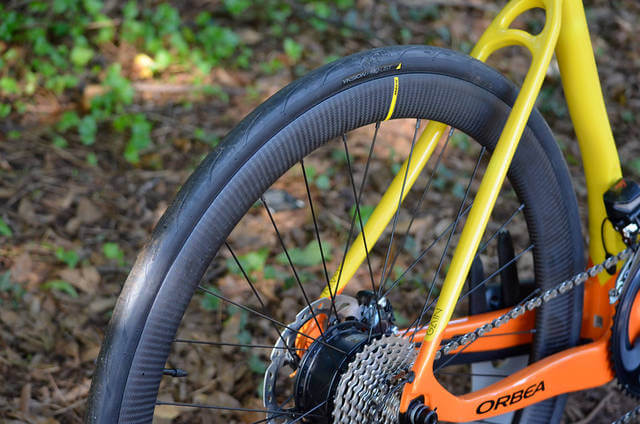
5. Use Aero Wheels & Boost Average Bike Speed
Upgrading your wheel with a more aerodynamic design can give you a extra jump in terms of speed. After all it is your wheel and tires that actually makes contact with the ground.
When looking for speed you should pick wheel with flexible sidewalls and reasonably thin tread. I personally use the Super team U Shape Bike Wheel Clincher 700C Carbon Wheel-set for my road bike.
It’s lightweight by construction, aerodynamic by design and feels like quality when riding. The best part it isn’t costly at all and feels exactly the same as some expensive Aero wheels. Get it on Amazon!
You’ll definitely feel an improvement in your bike performance on paved roads once replaced. If you choose well you can save as much as 500 grams on just wheels.
Even for the most common tires available, you will save at least 148g. Constructed of light rubber these high-quality tires will roll faster on roads and trails.
6. Efficient Gear Ratio For Average Bike Speed
Now, if you’re picking out a bike and want one that’s above all just the fastest, you’ll want to keep in mind the gear ratio. What is the gear ratio? Well, it’s the chains and chain housing seen on the front-end and back-end of your tires. The idea behind the gear ratio is simple enough.
Each gear will control how far the bike will go with each peddles stroke. On higher gear, the bicycle will go further while the opposite will happen on low gear.
The gears don’t extend the length of the bike or wheels but instead changes how far the wheels will rotate in regard to a single peddle turn.
A bike in high-gear will be faster than one in low-gear as the wheels are spinning much faster. The trade-off, as you might imagine, is faster bicycles will be harder to control on sharp turns or even a change in terrain.
So, when deciding on a bicycle and aiming for a fast one, it’s a good idea to look into the gears to see if the model you picked will provide you with the speed you crave.
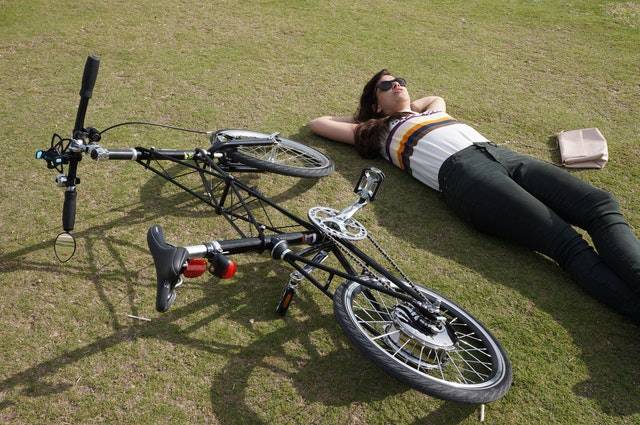
7. Brake Less Ride More
Its almost clear when you needs to improve your average bike speed you take shorter intervals, apply less brakes when riding and ride longer. You might consider riding with others as company helps us keep motivated and force you to keep up with other’s.
I have always seen myself riding faster, stopping less often and have a overall better experience riding with a group. Not to mention the improvement in my average speed cycling.
Find some bike group near you, its easier to contact them and join these days. All you need to do is search for bike groups with your area code, there are sites dedicated to this job and also some helpful Facebook groups.
Trust me you will never regret, it always helped me as community and will do the same for you.
Conclusion
By now you should understand the near futility of trying to create a meaningful average that applies to all avid cyclists equally.
However, by adding or subtracting from the baseline according to the effects of these various factors, hopefully you can arrive at a figure of some relevance to you.
Also Read,
Do Cycling Shoes Make You Faster (Avg Speed)


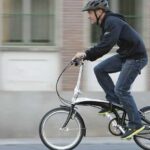



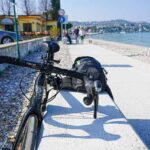


Leave a Reply